-

新人教版高中英语必修2Unit 4 History and Traditions-Reading and Thinking教案二
Step 5 While reading---Task 3Read the text again and answer the following questions.Q1: How many countries does the UK consist of ?4 Q2: What are the four countries of the United Kingdom?England, Wales, Scotland and Northern Ireland Q3: Which two were the first to be joined together ?England and WalesQ4: What are the two chief advantages of studying the history of a country ?The first one is to help you understand more about the country and its traditions.The second one is to make visiting it more enjoyable.Q5: What’s the author’s attitude towards studying the history ?Supportive/positiveStep 6 Post reading---Retell the textThe United Kingdom, Great Britain, Britain, England—many people are confused by (1)_____ these different names mean. In the 16th century, the nearby country of Wales (2) __________(join) to the Kingdom of England. In the 19 th century, the Kingdom of Ireland was added to create the United Kingdom of Great Britain and Ireland. Finally, the southern part of Ireland (3) ______ (break) away from the UK, which resulted in the full name we have today. However, most people just use the (4)_________(shorten) name: the UK. The four countries (5)__________ belong to the United Kingdom work together in some areas. There were four sets of invaders and the last group were the Normans. They had castles (6)_________(build) all around England and made changes (7)__________ the legal system. Studying the history of the country will make your visit much more (8)_________(enjoy). The capital city London is (9)___ ancient port city that has a history (10)______(date) back to Roman times. 1. what 2.was joined 3.broke 4.shortened 5.that 6. built 7.to 8.enjoyable 9.an 10.dating Step 6 Homework

新人教版高中英语必修2Unit 4 History and traditions教案
这个地区有着深厚的传统。既学既练:为了让更多的外国游客了解中国文化,欣赏中国美丽的自然风光,感受中国发生的巨大变化,某外文杂志社将出版一本英语小册子来介绍中国的旅游景点。该杂志社邀请你为该小册子写一篇英语短文来介绍杭州,内容包括:1.杭州的位置(中国东南部)、面积(16 000多平方公里)及历史(2 200多年)等;2.杭州的旅游特色(自然风景、传统文化、特色小吃等);3.希望更多的游客来杭州参观。注意:1.词数80左右;2.可适当增加细节,以使行文连贯。Located in the southeast of China, Hangzhou is a beautiful city.Dating back more than 2,200 years, Hangzhou covers an area of more than 16,000 square kilometers.In Hangzhou, you can visit the West Lake, whose scenery is fascinating.In addition, you can’t miss its cultural relics and historical sites, from which you will learn more about excellent Chinese traditional culture and traditions.In Hangzhou, the special snacks are famous and visitors from different parts of the world think highly of them.As a tourist attraction, Hangzhou attracts a large number of visitors from home and abroad every year.Once you come to China, Hangzhou is a scenic spot you can’t miss.

新人教版高中英语必修2Unit 5 Music-Discovering Useful Structures教案二
4. When he got absorbed in his world of music, he felt as if he could “see” the beauty of the world around him, like he had in his previous life.P·P as adverbial: _________________________________________________________________.Function: _______________________________________________________________________.Step 5 Solid Complete the passage with the words in brackets in their correct forms.Well known as a successful band, the Impact members show quite a few striking qualities. They never ever give up. When _____________(question) by the media, they are not _____________(discourage) and practise even harder. They are improving themselves by attending several master training class. They are united. _____________(fill with) team spirit, they act as a whole, always aiming for glory. Step 6 Difference and similarity from -ingObserve the following examples.1. He went out, shutting the door behind him.=He went out, ________________________________________________________.2. Not knowing what to do, he went to his parents for help.=__________________________________________, he went to his parents for help.Similarity: _______________________________________________________________________________________________________________________________________________________.Difference : _______________________________________________________________________________________________________________________________________________________.Step Practice1. ________ in a hurry, this article was not so good. 因为写得匆忙, 这篇文章不是很好。2. ________ carefully, he found something he hadn’t known before. 他仔细读书时, 发现了一些从前不知道的东西。3. ________ why he did it, the monitor said it was his duty. 当被问及他为什么要这么做时, 班长说这是他的职责

新人教版高中英语必修2Unit 5 Music-Listening&Speaking&Talking教案
choir memberspeople to run food stands people to sell festival ticketspeople to sell music CDspeople to set up equipmentmusical performersStep 2: Listen to the announcement again and answer the questions. ? 1. What kind of songs will Grace Davis sing at the festival?? 2. Who can try out as a performer?? 3. What can those who think they do not have musical talent do?? 4. How can students volunteer to take part?? Talking about preferences:? Would you prefer doing ..?? What would you prefer to do?? Would you rather do .... or ….?? What would you rather do?? I'd prefer .... to ..? I'd rather have ... than .. Step 3: Speaking ProjectWork in groups. Role-play the conversation or make a new one.? Debbie: Where have you been? You missed the announcement about the music festival.? John: I was at the doctor's office. Music festival?? Frank: Yes, it's going to be next month on the school sports field. John, you can play the piano. How about playing it at the festival?? John: Well, I'd rather play the violin. I can play Liang Zhu.? Frank: Wow! Sounds good. What about you, Debbie? ? Debbie: Actually, I don't have much musical ability. I'd prefer just to help out with the crowds.? Frank: You can sell tickets or work at a food stand.? John: So can I assume that the aim of the festival is to raise money?? Debbie: Yes. All of the money will go to charity.

新人教版高中英语必修2Unit 5 Music-Discovering Useful Structures教案一
Step1:自主探究。1.(教材P52)Born(bear) in the USA on 2 January 1970, Whitacre began studying music at the University of Nevada in 1988.2.(教材P52) Moved(move) by this music, he said, “It was like seeing color for the first time.”3.(教材P56)I was very afraid and I felt so alone and discouraged(discourage).4.(教材P58)Encouraged(encourage) by this first performance and the positive reaction of the audience, I have continued to play the piano and enjoy it more every day.Step2:语法要点精析。用法1:过去分词作表语1).过去分词可放在连系动词be, get, feel, remain, seem, look, become等之后作表语,表示主语所处的状态Tom was astonished to see a snake moving across the floor.汤姆很惊讶地看到一条蛇正爬过地板。Finally the baby felt tired of playing with those toys.终于婴儿厌倦了玩那些玩具。注意:1).过去分词作表语时与被动语态的区别过去分词作表语时,强调主语所处的状态;而动词的被动语态表示主语是动作的承受者,强调动作。The library is now closed.(状态)图书馆现在关闭了。The cup was broken by my little sister yesterday.(动作)昨天我妹妹把杯子打碎了。2)感觉类及物动词的现在分词与过去分词作表语的区别过去分词作表语多表示人自身的感受或事物自身的状态,常译作“感到……的”;现在分词多表示事物具有的特性,常译作“令人……的”。
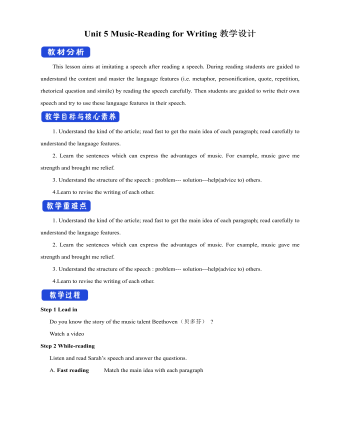
新人教版高中英语必修2Unit 5 Music-Reading for Writing教案二
The Internet celebrity Gao Yifeng. Years ago, he owned 5 companies and the staffs over 1,000, but during the economy crisis, he became nothing but debt. He was so worried that his hair became white overnight. There was a time when he wanted to killed himself. But after listening to the song Start Over by Liu Huan, he decided to cheer himself up. He started a steamed bun shop and gradually became a national chain shops. Now he became successful again.Walter Haddon said, “Music is the medicine of a troubled mind.” Music contains such a pleasant and inspiring force. Music gave him courage and bravery. When he listened to the song, it made his spirit fly like a kite in the wind. Music gave him strength and brought him relief. It was the rock I leant on to become strong and to get through those hard times. I hope none of us have to go through the same kind of suffering that he did. At the same time, we all go through various periods when we feel sad or alone. During those times, music can help us in the same way that it helped him. I hope we all will somehow begin to treasure music and make it a part of our life. Thank you for your listening !5.Revise your writing each other.Does he/she explain how music has changed his/her/someone else’s life?Are some of the rhetorical devices included and used properly ?Does he/she talk about how music makes him/her/someone feel?Is the first word in each sentences capitalised?Does he/she use correct punctuation ?
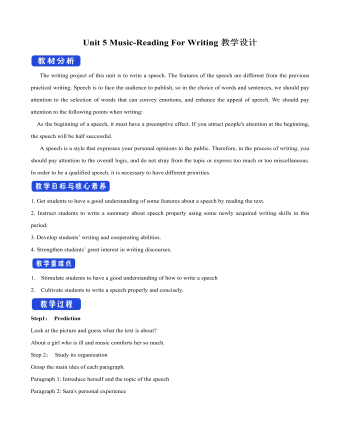
新人教版高中英语必修2Unit 5 Music-Reading For Writing教案一
(4)Now we have heard a number of outstanding speeches ... 我们已经聆听了许多精彩的发言……(5)Because we wanted the nations of the world, working together, to deal with ... 因为我们希望全世界各国团结起来去应对……(6)And if we do not act ... 如果我们不采取行动……(7)Now, I share the concerns that have been expressed ... 我也同意对于……表达的担心(8)Let us show the world that by working together we can ... 让我们告诉全世界,通过一起努力我们可以……(9)It is now time for us to ... 是时候我们……(10)And I have always wished that ... 我一直希望……(11)Thank you for letting me share this day with me.感谢你们和我共度这一天。实践演练:假如你是高中生李华,你校将举办一次以“音乐”为主题的演讲比赛,请你按照主题,写下你的演讲稿。注意:词数100左右。First of all, thank you for listening to my speech. My topic is: love music like love yourself.Music is like the air we need to maintain our normal lives around us. You can't imagine how terrible a world without music would be. Movies and TV shows have no music, only dry conversations and scenes; mobile phones only vibrations; streets only noisy crowds; cafes, western restaurants only depressed meals. What a terrible world it is!As a student, I hope we all can enjoy the fun brought by music in our spare time. Instead of just listening to music, we can even make our own music. Let's enjoy the fun of music!Thanks again for your attention!
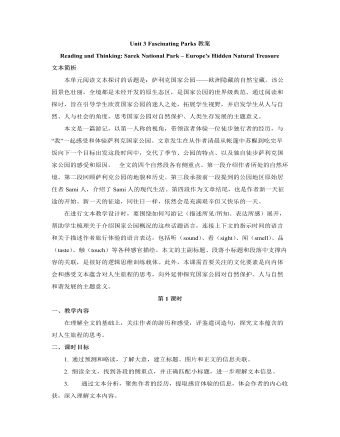
新人教版高中英语选修1Unit 3 Fascinating Parks教案
2. Explore the significance of the establishment of Sarek National Park.Q1: Which event is the most important one in the park’s history?Ss: The establishment of Sarek national park in 1909 is the most important one.Q2: Is it worth making a place like Sarek a national park? Give your reasons.Ss: Yes. In this way, the place can be kept in its natural state and natural beauties and other rare and valuable resources can be preserved instead of being destroyed by endless exploitation driven by profits.Q3: How does the writer organize his introduction to the history of Sarek?Ss: The writer organizes his introduction in the sequence of time, using time indicators such as “used to”, “around 9,000 years ago”, “soon after”, “following the reindeer”, and “in 1909”.Q4: What is the feature of the language used to introduce the history of the park?Ss: The introduction to the park is to provide facts, using time indicators to organize the events. Sentences starts with “third person” and passive voice is used more often, feeling objective.【设计意图】学生寻找和梳理公园历史上的重要事件,体会人与自然的和谐关系,评鉴介绍性语言的特点。【核心素养提升点】发展自主提取、梳理文本信息能力,训练逻辑思维和高阶思维。Activity 3: Highlighting the secret of the text
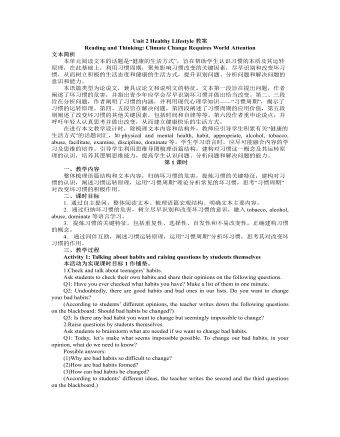
新人教版高中英语选修3Unit 2 Healthy Lifestyle教案
Activity 4: Figuring out the structure and the writing purpose 本活动为实现课时目标2。 1.Read Paragraph 6 and think about its main idea and the writer’s writing purpose. Q1: If you were the author, how would you end your article? “For young people, there is plenty of time to change bad habits. However, there is no “magic pill” or delete button that will help you; you have to think about your bad habits and decide on some changes. You have the power to build a happy and healthy life full of good habits!” Q2: What is Paragraph 6 mainly about? (Possible answer: to appeal to young people including teenagers to change bad habits and live a happy and healthy life.) 2.Think about the writer’s writing purpose and share opinions. Q1: What is the writing purpose? Work in pairs and figure it out. (Possible answer: On the one hand, the passage is written to help teenagers change their bad habits and live a healthy lifestyle. On the other hand, it provides us with a scientific way to identify and analyse our problems objectively, thus strengthening our resolve to tackle the seemingly common yet tough problems in our lives.) 【设计意图】 步骤1旨在预测和验证文章最后一段主要内容,梳理完整的语篇结构,步骤2旨在思考和讨论作者的写作目的。教师也可根据学生课堂反应情况融入对语篇人称多次转换的思考。
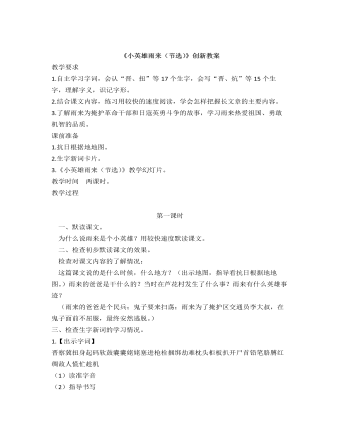
部编人教版四年级下册《小英雄雨来》创新教案
(二)提问:夜校的学习条件怎样?雨来在夜校里受到什么教育?默读第二段。指导朗读:“我们是中国人,我们爱自己的祖国。”“我们——是——中国人,我们——爱——自己的——祖国。”讨论段意和小标题。(段意:雨来上夜校,受到爱国主义教育。)(小标题:“雨来上夜校。”)(三)学习第三段。默读课文,提问:这段主要说了几层意思?学生默读课文,小组交流,展示如下:(两层意思:第一层从“有一天”至“只从街上传来一两声狗叫”,主要写鬼子开始扫荡了;第二层从“第二天”至这段结束,主要写雨来为掩护交通员李大叔,被鬼子捆绑起来了。)指导朗读第二层。重点朗读:“他抬头一看,是李大叔。”“咦!这是什么时候挖的洞呢?”“把缸搬回原地方。你就快到别的院里去,对谁也不许说。”讨论段意和小标题。段意:(雨来为掩护交通员李大叔,被鬼子捆绑起来了。)(小标题:“雨来掩护李大叔”。)
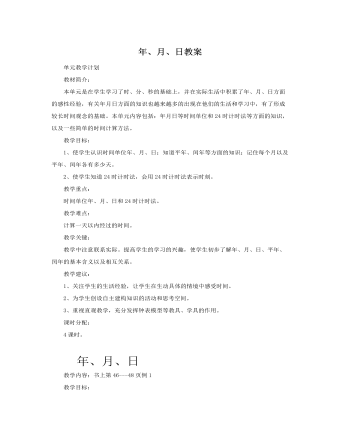
人教版新课标小学数学三年级下册年、月、日教案
大家请看,钟面上现在表示的是几时?(下午1时)下午1时我们还可以怎样表示?(13时)下午1时就是13时,你是怎么想到用13时表示的?在一日内,由于第一圈走了12小时,所以时针在走第二圈时,我们就要把时针指的钟面上的时刻数分别加上12,这就是我们今天要学习的24时记时法。比如,现在钟面上是下午1时,根据24时记时法就应该是?(13时)。那么下午2时、3时、6时、晚上7时30分、9时50分用24时计时法怎样表示?你是怎样想的?(继续看画面。)这时,同学们又开始了下午的学习生活。16时,同学们结束了一天的学习,回到了家中。时间一晃就到了21时,也就是我们常说的夜间九点。这时我们又该上床休息了。时间一分一秒地过去了,又是午夜12点,夜深人静,一天又过去了。这种用0时到24时来表示一天时间的记时方法我们就把它叫做24时记时法。师小结:同学们,一天的时间很快就会过去,我们要珍惜时间,合理地安排好一天的作息时间。4、观察钟面:你发现了什么?(同一指针可以表示晚上12时、0时、24时。)抽几个时间板书。观察普通计时法和24时计时法,发现他们有什么区别呢?同桌之间互相交流一下。
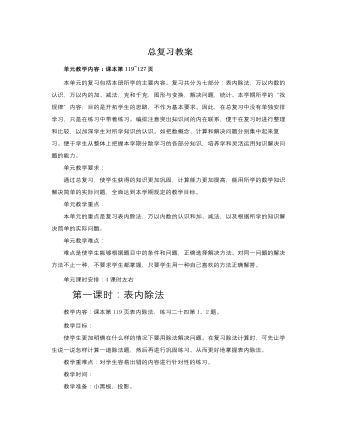
人教版新课标小学数学二年级下册总复习教案
教学时间:教学准备:小黑板,挂图。教学过程:一、复习旧知,引入新课。1、请大家想一想到今天为止,我们已经复习了本学期学过的哪些知识?(表内除法。万以内数的认识和加法、减法。克和千克及图形的变换。)2、对这些知识还有没有什么问题?还有没有内容是我们没有复习到或复习了掌握不好的?如果学生有问题,则针对问题,让同学们一起来想办法解决这些问题。学生提出问题,思考解决方法。二、复习整理:1、分别出示教材第122页第13、14题的挂图。(如果没有,就让学生直接看书)(1)看了图后,你明白图中的画是什么意思吗?学生看挂图,小组讨论这两题的意思。叙述两幅图的意思,没有说好的请其他同学来补充完整。在小组内讨论交流。(2)怎样来解决这两个生活中的实际问题?
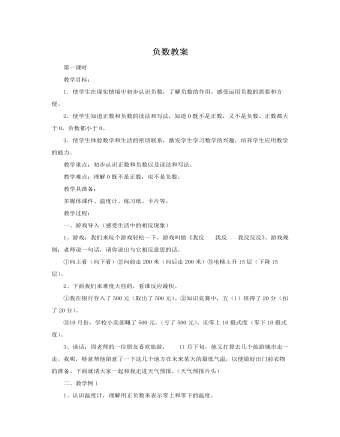
人教版新课标小学数学六年级下册负数教案
(3)教师在黑板上话好直线,在相应的点上用小图片代表大树和学生,在问怎样用数表示这些学生和大树的相对位置关系?(让学生把直线上的点和正负数对应起来。(4)学生回答,教师在相应点的下方标出对应的数,再让学生说说直线上其他几个点代表的数,让学生对数轴上的点表示的正负数形成相对完整的认识。(5)总结:我们可以像这样在直线上表示出正数、0和负数,像这样的直线我们叫数轴。(6)引导学生观察:A、从0起往右依次是?从0起往左依次是?你发现什么规律?B、在数轴上分别找到1.5和-1.5对应的点。如果从起点分别到.5和-1.5处,应如何运动?(7)练习:做一做的第1、2题。(二)教学例4:1、出示未来一周的天气情况,让学生把未来一周每天的最低气温在数轴上表示出来,并比较他们的大小。
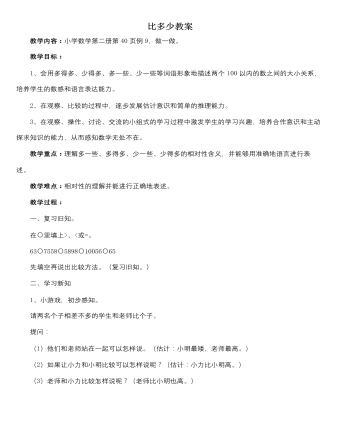
人教版新课标小学数学一年级下册比多少教案
教学目标:1、会用多得多、少得多、多一些、少一些等词语形象地描述两个100以内的数之间的大小关系,培养学生的数感和语言表达能力。2、在观察、比较的过程中,逐步发展估计意识和简单的推理能力。3、在观察、操作、讨论、交流的小组式的学习过程中激发学生的学习兴趣,培养合作意识和主动探求知识的能力,从而感知数学无处不在。教学重点:理解多一些、多得多、少一些、少得多的相对性含义,并能够用准确地语言进行表述。教学难点:相对性的理解并能进行正确地表述。教学过程:一、复习旧知。在O里填上>、<或=。63O7558O5898O10056O65先填空再说出比较方法。(复习旧知。)
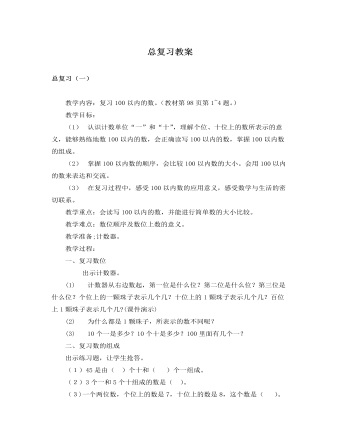
人教版新课标小学数学一年级下册总复习教案
教学内容:复习100以内的数。(教材第98页第1~4题。)教学目标:(1) 认识计数单位“一”和“十”,理解个位、十位上的数所表示的意义,能够熟练地数100以内的数,会正确读写100以内的数,掌握100以内数的组成。(2) 掌握100以内数的顺序,会比较100以内数的大小。会用100以内的数来表达和交流。(3) 在复习过程中,感受100以内数的应用意义,感受数学与生活的密切联系。教学重点:会读写100以内的数,并能进行简单数的大小比较。教学难点:数位顺序及数位上数的意义。教学准备;计数器。教学过程:一、复习数位出示计数器。(1) 计数器从右边数起,第一位是什么位?第二位是什么位?第三位是什么位?个位上的一颗珠子表示几个几?十位上的1颗珠子表示几个几?百位上1颗珠子表示几个几?(课件演示)(2) 为什么都是1颗珠子,所表示的数不同呢?(3) 10个一是多少?10个十是多少?100里面有几个一?
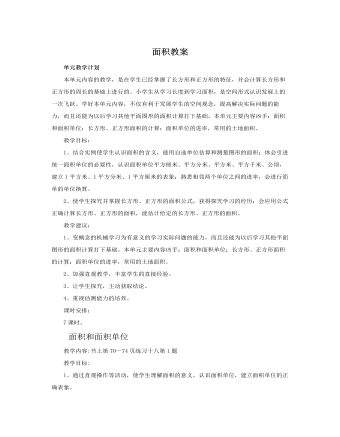
人教版新课标小学数学三年级下册面积教案
教学内容:书上第84页公顷、平方千米教学目标:1、让学生知道公顷、平方千米是更大的面积单位,了解1公顷、1平方千米的实际大小。2、知道1公顷=10000平方米,1平方千米=100公顷。3、培养学生的空间观察和动手操作能力,培养学生的爱国主义情感。教学重点:使学生了解1公顷、1平方千米的大小。掌握土地面积单位间的进率。教学难点:建立1公顷及1平方千米的实际概念,能区分两个单位。教学准备:课件教学过程:一、巩固旧知,作好铺垫。1、常用的面积单位有哪些?2、用打手势表示一下1平方厘米、1平方分米、1平方米的大小。3、填写正确的面积单位:指甲的面数学书本的封面黑板的面二、引入:同学们,我们一起来看看体育场的图片,你们有什么感想?出示:(体育场太大了)那还能用我们前面学过的面积单位进行测量吗?这就是我们今天要学的比平方米更大的面积单位:公顷和平方千米。(出示课题:公顷、平方千米)三、新授1、通常我们在测量土地面积时,要用到更大的面积单位,公顷和平方千米。它们到底有多大呢?这节课我们就来了解一下。
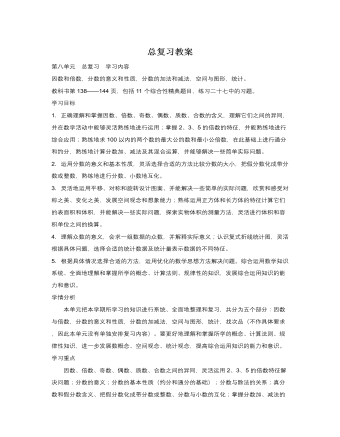
人教版新课标小学数学五年级下册总复习教案
此图是一个复式折线统计图,考察内容是根据统计图,进行数据的有效分析。(1)因为统计图中蓝色的折线表示学龄儿童,根据对学龄儿童的折线数据分析发现:1980年的学龄儿童最多,2000年的学龄儿童最少。(2)根据题目要求的分析:没上学的学龄儿童实际上是指:学龄儿童的人数与实际入学儿童人数的差。通过仔细观察统计图,可以直观地发现:1980年的学龄儿童和入学人数之间的差值最大,2000年的学龄儿童和入学人数之间的差值最小。所以,1980年没上学的学龄儿童最多,2000年的最少。(3)这一问比较开放,只要合理即可。三、练习二十七第9——14题解答指导:9. 81cm3=81ml 700dm3=0.7m3 560ml=0.56L 2.3dm3=2300cm310. 根据图示可知:把铁皮做成一个长方体,长方体的长为30—5×2=20(cm),宽为25—5×2=15(cm),高也就是切去的正方形的边长5cm。(1)求“这个盒子用了多少铁皮?”也就是求这个铁皮盒子(无盖)的表面积。
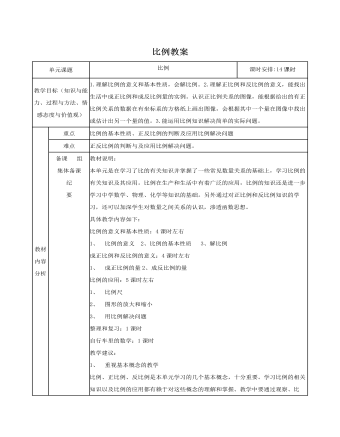
人教版新课标小学数学六年级下册比例教案
一、回顾旧知,复习铺垫1、上节课我们学习了一些比例的知识,谁能说一说什么叫做比例?比例的基本性质是什么?应用比例的基本性质可以做什么?2、判断下面每组中的两个比是否能组成比例?为什么?6:3和8:4 : 和 :3、这节课我们继续学习有关比例的知识,学习解比例。(板书课题)二、引导探索,学习新知1、什么叫解比例?我们知道比例共有四项,如果知道其中的任何三项,就可以求出这个比例中的另外一个未知项。求比例中的未知项,叫做解比例。解比例要根据比例的基本性质来解。2、教学例2。(1)把未知项设为X。解:设这座模型的高是X米。(2)根据比例的意义列出比例:X:320=1:10(3)让学生指出这个比例的外项、内项,并说明知道哪三项,求哪一项。根据比例的基本性质可以把它变成什么形式?3x=8×15。这变成了什么?(方程。)教师说明:这样解比例就变成解方程了,利用以前学过的解方程的方法就可以求出未知数X的值。
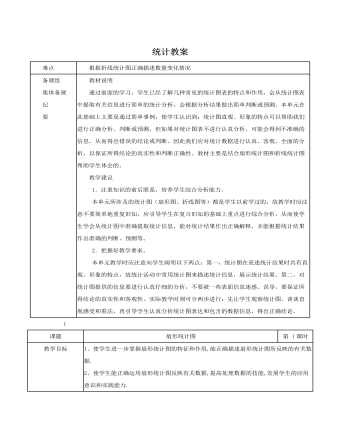
人教版新课标小学数学六年级下册统计教案
分别算出2008年比2007年各季度增产的百分数和合计数,再制成统计表.分析:根据题目要求,要算出各季度增产的百分数,我们只要根据2008年与2007年各个季度的原始数据,运用“求一个数是另一个数的百分之几”的方法就可以算出.算出了各个季度增产的百分数,根据题意制统计表时,既要按照季度分类,又要反映出年份的类别,所以在确定表头时可分为3部分:年份、台数、季度,年份又分为2007年产量、2008年产量、2008年比2007年增产的百分数.2、田力化肥厂今年第一季度生产情况如下:元月份计划生产1500吨,实际生产1620吨;二月计划生产1600吨,实际生产1680吨;三月份计划生产1640吨,实际生产1720吨,根据上面的数据,算出各月完成计划的百分数,并制成统计表.(1)制作含有百分数的统计表时,百分数这一栏一定要写清楚是谁占谁的百分之几,并按“求一个数是另一个数的百分之几”的解题方法正确算出对应百分数”

初中英语说课教案
(二) 教学目标 依据并结合新课程标准提出的基础教育阶段英语课程的总体目标和具体要求,我将本课教学目标设计如下: 知识目标: 让学生掌握其中的重要词汇mind, turn down, not at all等和句式would you mind doing sth? 并能让学生掌握如何运用所学句式提出礼貌请求以及礼貌的向他人道歉。

